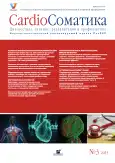The clinical efficacy of a comprehensive program of rehabilitation after coronary artery bypass grafting in patients with coronary artery disease under outpatient department cardio rehabilitation - III stage of rehabilitation
- Authors: Aronov D.M1, Ioseliani D.G2, Bubnova M.G1, Krasnitskiy V.B1, Novikova N.K1
-
Affiliations:
- State Research Center for Preventive Medicine of the Ministry of Health of the Russian Federation
- ГБУЗ Научно-практический центр интервенционной кардиоангиологии Департамента здравоохранения г. Москвы
- Issue: Vol 6, No 3 (2015)
- Pages: 6-14
- Section: Articles
- URL: https://journals.rcsi.science/2221-7185/article/view/45104
- DOI: https://doi.org/10.26442/CS45104
- ID: 45104
Cite item
Full Text
Abstract
Full Text
##article.viewOnOriginalSite##About the authors
D. M Aronov
State Research Center for Preventive Medicine of the Ministry of Health of the Russian Federationд-р мед. наук, проф., засл. деят. науки РФ, рук. лаб. кардиологической реабилитации ФГБУ ГНИЦ ПМ 101990, Russian Federation, Moscow, Petroverigskii per., d. 10, str. 3
D. G Ioseliani
ГБУЗ Научно-практический центр интервенционной кардиоангиологии Департамента здравоохранения г. Москвычл.-кор. РАН, д-р мед. наук, проф., дир. ГБУЗ НПЦ ИК 101000, Russian Federation, Moscow, Sverchkov per., d. 5
M. G Bubnova
State Research Center for Preventive Medicine of the Ministry of Health of the Russian Federation
Email: mbubnova@gnicpm.ru
д-р мед. наук, проф., рук. отд. реабилитации и вторичной профилактики сочетанной патологии с лабораторией профилактики атеросклероза и тромбоза ФГБУ ГНИЦ ПМ 101990, Russian Federation, Moscow, Petroverigskii per., d. 10, str. 3
V. B Krasnitskiy
State Research Center for Preventive Medicine of the Ministry of Health of the Russian Federationканд. мед. наук, вед. науч. сотр. лаб. кардиологической реабилитации отд. реабилитации и вторичной профилактики сочетанной патологии ФГБУ ГНИЦ ПМ 101990, Russian Federation, Moscow, Petroverigskii per., d. 10, str. 3
N. K Novikova
State Research Center for Preventive Medicine of the Ministry of Health of the Russian Federationканд. пед. наук, ст. науч. сотр. лаб. кардиологической реабилитации отд. реабилитации и вторичной профилактики сочетанной патологии ФГБУ ГНИЦ ПМ 101990, Russian Federation, Moscow, Petroverigskii per., d. 10, str. 3
References
- Россия 2014: Статистический справочник. Росстат. М., 2014.
- Mathers C.D, Loncar D. Projections of global mortality and burden of disease from 2002 to 2030. PloS Med 2011; 3: e442.
- Nichols M, Townsend N, Scarborough P, Rayner M. Cardiovascular disease in Europe: epidemiological update. Eur Heart J 2013; 34: 3028-34.
- Бокерия Л.А., Гудкова Р.Г. Сердечно - сосудистая хирургия - 2003. Болезни и врожденные аномалии системы кровообращения. М.: Изд - во НЦССХ им. А.Н.Бакулева РАМН, 2004.
- Smith P.K, Anderson J.L, Bittl J.A et al. ACCF/AHA Guideline for Coronary Artery Bypass Graft Surgery. J Am Coll Cardiol 2011. doi: 10.1016/j.jacc. 2011. 08.009.
- Head S.J, Davierwala P.M, Serruys P.W et al. Coronary artery bypass grafting vs. percutaneous coronary intervention for patients with three - vessel disease: final 5-year follow - up of the SYNTAX trial. Eur Heart J 2014; 35: 2821-30.
- Windecker S, Kolh P, Alfonso F et al. 2014 ESC/EACTS guide lines on myocardial revascularization: the task force on myocardial revascularization of the European Society of Cardiology (ESC) and the European Association for Cardio-Thoracic Surgery (EACTS) developed with the special contribution of the European Association of Percutaneous Cardiovascular Interventions (EAPCI). Eur Heart J 2014; 35: 2541-619.
- Kataoka Y. Analysis of 100 Aorto - coronary Artery Bypass Surgery - Especially about the Graft Patency. J Jap Ass Thorac Surg 1982; 30 (9): 1507-13.
- The Bypass Angioplasty Revascularization Investigation (BARI) Investigators. Comparison of coronary bypass surgery with angioplasty in patients with multivessel disease. N Engl J Med 1996; 335: 217-25.
- Rozanski A, Blumenthal J.A, Davidson K.W et al. The epidemiology, pathophysiology, and management of psychosocial risk factors in cardiac practice: the emerging field of behavioral cardiology. J Am Coll Cardiol 2005; 45: 637-51.
- Strike P.C, Steptoe A. Systematic review of mental stress - induced myocardial ischaemia. Eur Heart J 2003; 24: 690-703.
- Taylor R.S, Brown A, Ebrahim S et al. Exercise - based rehabilitation for patients with coronary heart disease: a systematic review and meta - analysis of randomized trials. Am J Med 2004; 116: 682-97.
- Hammill B.G, Curtis L.H, Schulman K.A et al. Relationship between cardiac rehabilitation and long - term risks of death and myocardial infarction among elderly Medicare beneficiaries. Circulation 2010; 121: 63-70.
- Аронов Д.М., Зайцев В.П. Методика оценки качества жизни больных с сердечно - сосудистыми заболеваниями. Кардиология. 2002; 5: 92-5.
- Красницкий В.Б., Аронов Д.М., Джанхотов С.О. Изучение физической активности у больных ИБС с помощью специализированного Опросника Двигательной Активности «ОДА-23+». Кардиоваск. терапия и профилактика. 2011; 8: 90-7.
- Myers J, Prakash M, Froelicher V et al. Exercise capacity and mortality among men referred for exercise testing. N Engl J Med 2002; 346: 793-801.
Supplementary files







